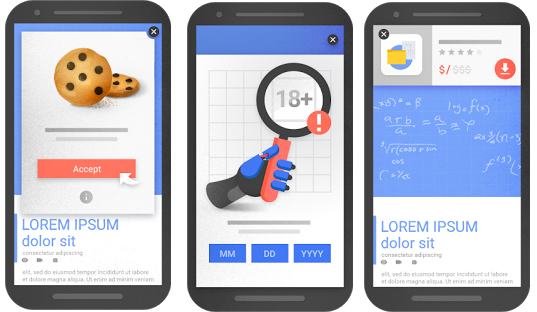
What to Know About Google’s New SEO Update for Mobile Popups
On January 10, 2017, Google will make a search engine optimization (SEO) update to how mobile users search for and find relevant information. The change is intended to create a better user experience — but it brings some mobile popups under fire.
Starting in 2017, mobile sites will need to change the way they think of popups.
Interstitials Defined
According to Google:
“Pages that show intrusive interstitials provide a poorer experience to users than other pages where content is immediately accessible.”
Wondering what “interstitial” means? Here’s the definition:

Google’s talking to you, mobile popups. Because cell phone screens are small anyway (and come in way too many sizes), ensuring the end user has a positive experience is all the more important.
Google has hundreds of signals that rate your website, in turn deciding where you rank on Google. While popup notifications are only one signal in the large list, including popups on your mobile site can start a downward spiral to lower SEO rankings in the future.
But that doesn’t mean you have to do away with popups entirely.
Good Popups vs. Bad Popups
Good Popups
Not all popup notifications are created equal. There are mobile popups that Google is happy not to penalize.
Here’s a list of “good” popups that will not affect your SEO:
-
- Cookie usage notifications (shown below left)
-
- Age verification boxes (shown below middle)
-
- App-install interstitials
-
- Private content login dialogs
- Small banners that are easily dismissible and do not obscure a high percentage of the screen (shown below right)
Here are some examples of Google’s “good” popups:
If you’re wondering where your mobile popup falls, and it doesn’t seem to fit in the list above . . . Google probably thinks it’s intrusive.
Bad Popups
Hundreds of thousands of websites include popups, but Google will dock search rankings for mobile popups that it considers intrusive.
Here’s a list of “bad” popups that Google will penalize:
-
- Popups that cover main content, either immediately upon entering the site or while scrolling down through content (shown below left)
-
- Popups where the layout takes over the above-the-fold portion of the page (shown below middle)
- Stand-alone popups that have to be dismissed before content can be read (shown below right)
Here are some examples of Google’s “bad” popups:
Websites that have heavily used popups as a form of profit will now have to decide which is more important: the quantity of their profit or the quality of their search results.
Why Only Mobile?
In 2015, 51% of Internet usage was accessed on a cell phone. As Internet usage on a desktop continues to decrease (down to 42% of users in 2015), the need for a mobile-first approach is imminent.
Google has been actively implementing mobile-responsive SEO protocol since 2014.
Remember the days when you had to zoom in on your cell phone to read a website? In 2014, Google started rewarding websites that were friendly for anyone searching from a mobile phone. Within just two years, Google has hugely impacted the mobile industry, with 85% of all websites now meeting Google’s mobile-responsive criteria.
With its new announcement of SEO changes for interstitials, Google also announced it would drop the mobile-friendly tag from website search results for a more uncluttered look. The search engine will still crawl websites for mobile responsiveness, but it won’t be noted.
But the question remains: why does this change only affect mobile sites?
If you receive a popup notification on a desktop, it’s far easier to click out of the popup. Mobile devices, with more than 5,500 screen resolutions to choose from, have such varying sizes that most websites cannot be responsive to every phone. That makes clicking out of popups pretty frustrating for the end user.
Yes, popups are intrusive on desktop sites too — but fat-finger syndrome isn’t as big of a deal on a desktop.
Become an SEO Superstar
Learning the ins and outs of search engine optimization can be overwhelming. That’s why at 9 Clouds, we take automotive SEO seriously. We want to help you look like an SEO superstar.
Here’s a guide to get started, but don’t be afraid to leave the majority of the work up to us.









